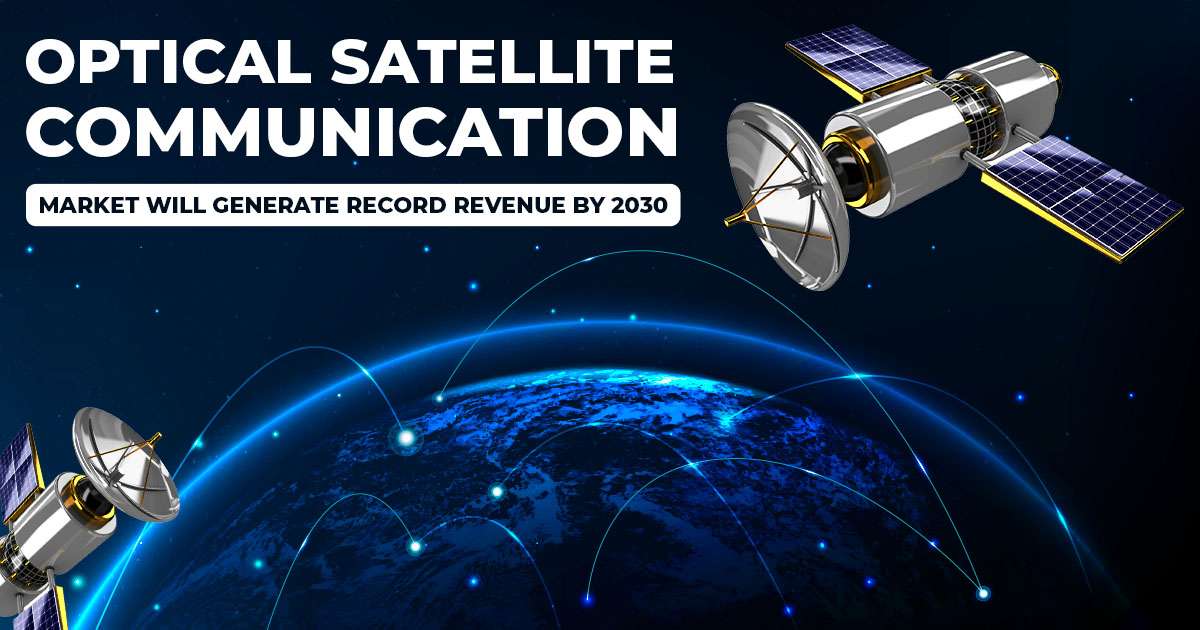The Optical Satellite Communication Market has evolved rapidly in recent years. It is poised for an outstanding growth trajectory. It is assessed to reach a staggering USD 13.1 billion by 2032, demonstrating a robust CAGR of 27.6% from 2024 to 2032.
- In 2022, the YAG laser sub-segment, a dominant force in the market, commanded an impressive 25% share, reflecting its strong performance and promising future prospects.
- In 2022, the North American satellite communication market value settled at around USD 676.8 million.
- The Asia-Pacific optical communication market will grow at a record CAGR of more than 28% from 2023 to 2032.
Optical Satellite Communication Meaning:
Optical Satellite Communication, also called Free-space optical communication (FSO). It employs light transmission through free space, be it air, vacuum, or similar mediums, to transmit data for computer networking wirelessly or telecommunications.
Unlike utilising solid mediums, such as optical fibre cables, this innovation proves useful where physical links are ineffective due to higher costs or some other considerations.
North America holds a notable share of the global optical satellite communication market, primarily driven by fast growth in the telecommunications sector.
The development of the Internet, connected with global telecommunications traffic, drives market growth worldwide. The growing number of Internet users and soaring telecommunication demands have led to multiple private entities.
This will make them invest in the optical satellite communication market, desiring feasible solutions to accommodate the need for undisturbed communication.
Global Optical Satellite Communication Market Dynamics
Market Opportunities:
- Integrating with emerging technologies (e.g., 5G, IoT)
- Development of rural connectivity.
- Growth in satellite constellation designs.
Market Drivers:
- Improvements in telecommunications technology.
- Growing demand for high-speed connectivity.
- Increasing telecommunication traffic worldwide.
- Developing global internet penetration.
Market Restraints:
- Weather conditions and atmospheric interference.
- Troubles in cost-efficient implementation.
- Spectrum and regulatory allocation issues.
Optical Satellite Communication Market: Report Scope
| Report Attribute | Details |
| Base year for estimation | 2023 |
| Historical data/Actual estimate | 2018-2023 |
| Market representation | Revenue in USD billion and CAGR from 2024 to 2033. |
| Forecast period | 2024-2028-2033 |
| Market size value in 2024 | $14.5 billion |
| Revenue Forecast in 2033 | $38.49 billion |
| Growth rate | CAGR of 27.6% from 2024 to 2033 |
| Regional scope | North America, Latin America, Asia Pacific, Europe, and Middle East & Africa |
| Segments Covered | component transmission medium laser typegeographyapplication |
| Key companies profiled | Analytical Space Inc.ATLAS Space OperationsBall Aerospace & Technologies Corp.BridgeSat Inc.HisdesatServiciosEstrategicos S.A.Laser Light Communications Inc.Maxar Technologies Ltd.Mitsubishi Electric CorporationMynaric AGSITAEL S.p.A |
| Forecast unit | Value (USD Million) |
Optical Satellite Communication Market Insights:
Governments across multiple nations invest in different optical communication projects to demonstrate high-data-rate connections. For example, recently, NASA entered an agreement with BridgeSat Inc. to produce a space optical communication system.
Additionally, the European Space Agency uses optical data-relay services like EDRS. It is used to launch the Copernicus earth observation project with 5 LEO satellites facilitating optical communication for the transmission of data.
There are some advantages of optical satellite communication that position it as a promising prospect for upcoming networks, including:
- Significant bandwidth.
- Reduced power requirements.
- Precise beam targeting.
- Unlicensed spectrum usage.
- High directivity.
- Enhanced security.
These stand out, especially for high-capacity backhaul links that are necessary for high-data-rate demands, including those anticipated in networks like 5G.
Wireless communication benefits include easy operational maintenance, lower deployment costs, and network topology flexibility. The growing number of smartphone users worldwide has boosted the demand for high-speed data transmission.
Moreover, the increase of multimedia services like file sharing, video-on-demand, and audio streaming has upscaled the need for expansive network bandwidth.
Additionally, the selection of advanced technologies, such as the Internet of Things and Machine-to-Machine communication, further fuels the need for high-data-rate solutions. It helps catalyzing the global optical satellite communication market.
The escalating need for steady communication across multiple industries exerts significant pressure on existing network infrastructures. It fosters a demand for optical communication to foster high-bandwidth traffic transmission on global or regional scales.
Moreover, the increasing adoption of optical communication services by the media sector drives the overall market growth. The increasing demand for live broadcasts of news content, entertainment, commercial advertising, sports, and real-time events is assured to drive the optical satellite communication market in the future.
Optical Satellite Communication Market: Segmentation Analysis
The global market for optical satellite communication is divided by transmission mediums, components, geography, laser type, and application.
Transmission Mediums:
- Intersatellite Links
- Wireless
Components:
- Receiver
- Transmitter
- Modular
- Demodulator
- Others
Geography:
- North America: The US & Canada.
- Asia-Pacific: India, South Korea, China, Japan, Australia, and the rest of Asia-Pacific.
- Europe: Germany, the UK, Spain, France, and the rest of Europe.
- Latin America: Mexico, Brazil, and the rest of Latin America.
- The Middle East & Africa: The Gulf Cooperation Council (GCC) countries, South Africa, and the rest of the Middle East and Africa.
Laser Type:
- AIGaAs Laser Diode
- YAG laser
- Microwave Laser
- Silex Laser
- CO2 Laser
Applications:
- Research & Space Exploration
- Monitoring & Tracking
- Security & Surveillance
- Last Mile Access
- Earth Observation
- Others
Optical Satellite Communication Market: Regional Analysis
Currently, North America maintains a ruling position in the optical satellite communication market. This position is anticipated to be upheld in the forecasted period. Canada and the United States act as primary drivers, with notable contributions from government funding for space projects further driving the market growth.
Furthermore, the Asia-Pacific region expects the fastest growth in the market. Countries like Japan, India, and China present encouraging markets due to the rising adoption of optical communication.
These countries feature substantial potential for market growth. It is driven by the increasing use of Internet services, satellite research, digital satellite telecommunications, and development initiatives, among other contributing factors.
Conclusion
The global market for optical satellite communication is poised for exceptional growth, featuring a robust CAGR of 27.6% from 2024 to 2032. Revenue is anticipated to be $38.49 billion in 2033. We have listed its complete analysis to help you understand it.
FAQs
Optical satellites work by capturing spectral bands on the seeable spectrum, with some abilities on either side.
Optical communication, also known as optical telecommunication, is basically communication at a distance using light to carry out information.
There are two kinds of optical fiber: single-mode and multi-mode optical fibers.
There are three kinds of satellite communication services: broadcasting, telecommunications, and data communications.
Also Read About: Cybersecurity Threats in 2024: What You Need to Know




